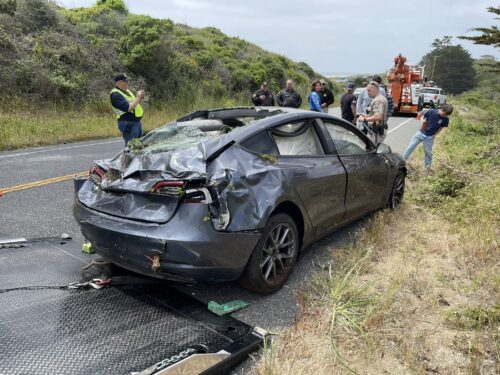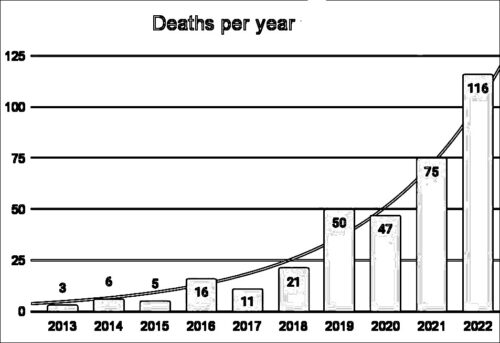I know Bean Hollow Road on Highway 1 very well. I’ve been there countless times, even on the motorcycle.
A terrible crash was reported Tuesday evening. A southbound 2022 Tesla collided at 6:39PM head-on into northbound traffic, spinning itself and another vehicle out of control down an east-side embankment into a lagoon.

The Tesla was traveling so fast it became completely submerged under 4 feet of water into thick mud.

Here you can see the Tesla was recovered near the middle area of the lagoon, after rolling down the embankment just before a blind curve to the right (note large hill to the left, which obscures the approaching curve when southbound).
CHP claim they are unable yet to place blame on who “veered” over the double-yellow line, straight into opposing traffic, despite nearly a decade of Tesla crashes that have similar indicators as this one.
“At this point,” he said, “we don’t know exactly what caused it, or which vehicle first crossed over the yellow line.”
Ok, but as a northbound car was smashed far east into that lagoon, it seems safe to start with an assumption a southbound car drifted across the lines and hit at high speed before it too went eastward into the lagoon.

Here’s the view of the front left side of the Tesla and totally compromised cage, giving a sense of the impact force under a posted speed limit of 55 mph. Looks more like 70 mph and rolling end over end.

The catastrophic level of damage and huge distance the Tesla flew from the road into deep mud suggests high speed approaching a blind right curve, which should be easy for investigators to determine. It may be the Tesla didn’t see/make the slight curve and ended up in the other lane as a northbound car suddenly came around the hill.
Given 2022 Tesla tend to be less safe than earlier models, it will be interesting to find out whether dangerous “crap” engineering was responsible. Is it yet another camera blindness case, driving straight instead of turning? Or maybe Tesla driver was hands on wheel looking backwards at the lovely Bean Hollow beach while steering too far left.
It just seems rather implausible for a northbound car to oversteer its mass west over the double yellow yet send both cars flying so far to the east. Also it proves, yet again, that Tesla’s many fraudulent claims about “collision avoidance” to juice investments since 2016 have always been a fraud.

There have been crashes in this spot before, yet never with this level of damage. Why did the driver in the other car die? Likely speed. Tesla is unique in increasing harms on roads because its CEO shamelessly pushes owners to ignore even Tesla’s own warnings about safe operation of a vehicle, while giving them a far more dangerous high-speed vehicle.
It would be better if Tesla either stopped warning it’s drivers about danger, or if it’s CEO stopped overpromising false safety, because the combination of the two is the worst possible situation.
In other words, if it was just a CEO lying about safety people would likely become skeptical. Or if it was just a carbrand warning about dangers, people would likely be mindful. Instead, the “authoritative” lies next to generic warnings negate important mindfulness, a sad social engineering trick that a CEO has been abusing to get more drivers… killed.
With this crash the Tesla death toll is likely to rise over 400, with over 50 people killed just in the first half of 2023.
When does it become mass murder?


